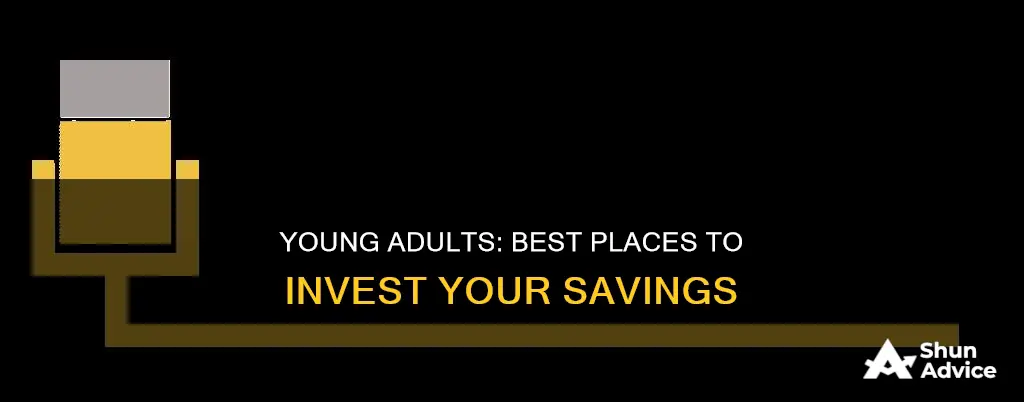
Investing can be intimidating, but it's never too early to start. Starting in your 20s allows for many years of compound interest to build up your retirement savings. While it can be challenging to save for retirement on an entry-level salary with student loan debt, it's important to save what you can. Financial advisors recommend saving 15% to 20% of your income for retirement, emergencies, and major purchases. If you're a 25-year-old earning the median salary for your age group, you should aim to have about $20,000 in savings.
There are several investment options to consider, such as starting a retirement savings plan or purchasing a home. You can also look into high-yield savings accounts, which offer higher interest rates than traditional savings accounts. When it comes to investing, diversification is key. Putting your money into different types of investments, such as stocks, bonds, or real estate, can help you build wealth over time.
| Characteristics | Values |
|---|---|
| Age | 25 |
| Savings | $20,000 |
| Savings rate | 15%-20% of income |
| Investment types | Retirement savings, stocks, real estate, bonds, mutual funds, ETFs, savings accounts, CDs, etc. |
| Investment vehicles | IRA, 401(k), high-yield savings accounts, money market funds, etc. |
| Time horizon | Long-term (retirement) |
| Risk tolerance | Higher risk tolerance due to age |
| Investment strategy | Buy-and-hold, index funds, diversification |
| Emergency fund | Recommended: 3-6 months' living expenses |
| Debt repayment | Prioritize credit card debt over student loans |
| Health insurance | Budget for it, especially if losing parental coverage |
| Side hustles | Consider for extra income |

Retirement savings
Understand Your Options
First, it is crucial to understand the variety of accounts available for retirement savings, such as tax-advantaged accounts offered by employers and other types of retirement accounts that can be opened and managed independently. These options include 401(k) plans, 403(b) tax-sheltered annuity plans, 457(b) deferred compensation plans, and Individual Retirement Accounts (IRAs). Each type of account has different features, contribution limits, and tax advantages, so it is important to choose the ones that best fit your employment situation and financial goals.
Take Advantage of Employer-Sponsored Retirement Accounts
Employer-sponsored retirement accounts, such as 401(k) plans, often have higher contribution limits than IRAs. For example, in 2024, the contribution limit for a 401(k) is $23,000, while the limit for an IRA is $7,000. Additionally, employer-sponsored plans may offer matching contributions, which can boost your savings even further. Many companies will match employee contributions up to a certain percentage of their salary. Taking advantage of these plans can help you reach your retirement goals more quickly and may even enable you to retire early or maintain a more luxurious lifestyle during retirement.
Automate Your Retirement Contributions
Automating your retirement contributions is a simple and effective way to ensure you consistently meet your investment goals. It eliminates the temptation to delay or divert your contributions for other purposes. Automation also makes it easier to plan your annual contributions and set up a realistic timeline for achieving your goals.
Create an Emergency Fund
An emergency fund is crucial to achieving your retirement goals. Unexpected expenses will inevitably arise throughout your life, and having a well-funded emergency fund will help you avoid dipping into your retirement savings or taking out early withdrawals or loans, which can come with financial consequences and hinder the growth of your retirement nest egg. Financial experts generally recommend setting aside three to six months' worth of living expenses in an emergency fund and regularly reviewing it to ensure it aligns with your lifestyle and inflation.
Use the Power of Compounding
Starting to save for retirement early allows you to take advantage of compounding, where the money you invest earns returns, and those returns also generate their own returns over time. The power of compounding increases the longer you invest, so starting in your 20s gives you a significant advantage. For example, investing $500 per month from age 25 to 65 in an account with an average annual return of 8% would result in savings of over $1.5 million, compared to only $240,000 if you kept the money in a non-interest-bearing account.
Other Considerations
- Asset Allocation: When investing for retirement, consider diversifying your portfolio across different asset classes, such as stocks, bonds, cash, and real estate. Younger investors can generally tolerate more risk and may choose an asset allocation with a higher percentage of stocks, while those closer to retirement may want to shift to more stable, low-earning funds.
- Save a Percentage of Your Income: Saving 15% of your income each year, including any employer contributions, is a common recommendation for building a comfortable retirement nest egg.
- Maximize Tax Benefits: Take advantage of tax-advantaged retirement accounts, such as traditional IRAs or Roth IRAs, to minimize taxes and maximize your savings.
- Financial Reassessment: Periodically reassess your finances to ensure you are maximizing your savings potential. This includes reviewing loan interest rates, refinancing options, tax filing strategies, and budgeting.
Savings-Investment Spending Identity: Lessons for the Economy
You may want to see also

Emergency funds
Determine Your Monthly Expenses
The first step in building an emergency fund is to calculate your essential monthly expenses. These typically include housing, transportation, food, healthcare/insurance, utilities, and other household expenses. Add up all these costs to get your average monthly spending.
Set a Target Amount
The general rule of thumb for emergency funds is to have enough to cover three to six months' worth of essential expenses. For example, if your monthly expenses are $2,000, your target emergency fund would be $6,000 to $12,000. However, this range can vary depending on your personal situation.
Start Saving
The next step is to start saving towards your target amount. If you're just starting, aim to save at least $1,000 as a preliminary goal. You can put aside a small amount each week or month and gradually build up your fund. Consider it a bill that you have to pay each month to help you stay disciplined.
Choose the Right Account
It's important to keep your emergency fund in an easily accessible, liquid account. A savings account is usually a good option, and you can look for high-yield savings accounts that offer higher interest rates. Money market accounts are another option, typically offered by banks and credit unions, but they may have higher minimum balance requirements and withdrawal limits.
Prioritize Your Emergency Fund
Make your emergency fund a priority by automating your savings. You can set up direct deposits or recurring transfers from your checking account to ensure you save consistently. Treat your emergency fund contributions like any other bill or expense, and try to live beneath your means to save more.
Avoid Withdrawing from Retirement Accounts
If possible, avoid tapping into your retirement accounts, such as your 401(k) or IRA, for emergency funds. Withdrawing from these accounts before retirement age can result in taxes and early withdrawal penalties. It's better to keep your emergency fund separate and only use it for unforeseen expenses.
Consider Insurance
In addition to your emergency fund, insurance can provide additional protection. Disability insurance and health insurance are important to have, especially if you lose your job and your employer-provided health coverage. Ensure you have adequate coverage to reduce the need to withdraw from your emergency savings in case of medical issues.
Remember, the key to successful emergency fund savings is discipline and consistency. Start saving early, make it a habit, and you'll be prepared for whatever life throws your way.
Saving Relationships: Worth the Investment?
You may want to see also

Paying off credit cards
Paying Off Credit Card Debt
Paying off credit card debt can have several benefits for 25-year-olds looking to invest their savings. Here are some reasons why it's a good idea:
Minimize Interest
Paying off your credit card balance every month can help you avoid interest charges on new purchases. Credit cards can charge different types of interest depending on how you use them. For example, using your card to make a purchase at a grocery store may result in different interest charges than those of a cash advance. By clearing your balance each month, you can avoid these extra costs.
Improve Credit Scores
Paying off credit card debt consistently and on time can help improve your credit scores. One factor that affects your credit score is your credit utilization ratio, which is the percentage of total available credit you're using. The lower your credit card balance, the lower your credit utilization, and therefore the better it is for your credit scores. This can make it easier to qualify for better interest rates and loans, such as mortgages.
Invest in Your Future
By paying off credit card debt and avoiding interest, you can free up money to invest in your future. You could build an emergency fund or save for retirement. With less debt to worry about, you may also have more flexibility in your budget.
Reduce Stress and Improve Health
Being in debt can be a significant source of stress, which can negatively impact your mental and physical health. According to experts, people with debt are more likely to suffer from worry-induced depression, anxiety, and stress. Paying off your debt can help eliminate these negative psychological and physical effects, leading to improved overall well-being.
Strengthen Relationships
Debt can be a major cause of stress in relationships, but resolving financial difficulties can improve relationships that were once strained due to money troubles. Working together towards a common financial goal can strengthen your bond and improve your ability to communicate honestly with your partner.
Investment Options for College Savings: What Are Your Choices?
You may want to see also

Health insurance
Investing in health insurance is a great option for 25-year-olds. Health insurance can provide a vital financial safety net if you get sick or injured. While you may not need as many healthcare services as older people, having health insurance can give you peace of mind and protect you from unexpected medical costs. Here are some things to consider when investing in health insurance as a 25-year-old:
Staying on Your Parent's Plan
If you're a 25-year-old, one of the cheapest ways to get health insurance is to stay on your parent's health insurance plan. The Affordable Care Act allows young adults to be covered by their parent's insurance until the age of 26. This option is available regardless of your marital status, living situation, or whether you are claimed as a tax dependent. It's important to note that some states and plans may have different rules, so be sure to check with the employer or plan provider.
Employer-Sponsored Health Plans
If your employer offers a group health insurance plan with low or no premiums, this may be a good option for you. However, be sure to review the plan's out-of-pocket costs, such as deductibles, coinsurance, and out-of-pocket maximums, as these can be high even with low premiums.
Medicaid
Medicaid offers no-cost or low-cost health insurance if you meet certain income requirements or have certain life situations. It provides similar levels of coverage to private health insurance and is available in all states. You can qualify based on factors such as income, family situations like pregnancy or having young children, and disability.
Affordable Care Act (ACA) Health Insurance Plans
You can purchase an ACA health insurance plan from your state or federal marketplace at HealthCare.gov. These plans are often more affordable for young adults compared to older individuals. When comparing plans, consider both the premiums and out-of-pocket costs, such as deductibles and coinsurance.
Catastrophic Health Insurance
If you are under 30, you are eligible for a catastrophic health insurance plan, which offers similar benefits to an ACA plan but with lower premiums and higher deductibles. This type of plan can provide protection against worst-case scenarios at a lower cost.
Student Health Plans
If you are a student, you may be able to enroll in a student health plan, which can help you meet the requirements for having health coverage under the healthcare law.
When investing in health insurance, it's important to consider your specific needs, budget, and eligibility for different plans. Compare the costs, benefits, and provider networks of each option to make an informed decision.
How Interest Rates Affect Savings and Investments
You may want to see also

401(k)
A 401(k) is a retirement savings plan offered by employers to their employees. It is one of the most popular ways to save for retirement, especially for young people who are just starting out in their careers.
Tax Benefits
Employer Matching
One of the biggest advantages of 401(k) plans is that employers often match your contributions up to a certain percentage of your salary. This means free money towards your retirement savings. For example, an employer might match your contributions at 50% up to 6% of your salary or at 100% up to 3% of your salary. By not taking advantage of employer matching, you are essentially leaving money on the table.
Higher Contribution Limits
Compound Interest
Starting to save for retirement early in your career allows you to take advantage of compound interest. The money you invest earns returns, and those returns also generate their own returns over time. The earlier you start, the more time your money has to grow and compound, resulting in a larger retirement fund.
Automation
You can automate your 401(k) contributions so that they are deducted directly from your paycheck and invested in your chosen funds. This ensures that you save consistently and helps you develop a habit of saving for retirement.
In summary, a 25-year-old should consider investing their savings in a 401(k) to benefit from tax advantages, employer matching, higher contribution limits, compound interest, and the convenience of automation. It is a great way to start building a secure financial future.
Savings or Investing: Where Should Your Money Go?
You may want to see also
Frequently asked questions
A 25-year-old should consider investing their savings in a variety of asset classes such as stocks, bonds, real estate, and retirement accounts like a 401(k) or an IRA.
A good way to invest in stocks is through index funds or exchange-traded funds (ETFs). These funds hold a variety of stocks and are designed to mimic the performance of a stock market index, such as the S&P 500.
Investing in index funds or ETFs provides diversification and reduces the risk of losing all your money if one stock performs poorly. It also saves time and research compared to picking individual stocks.
According to financial advisor Brian Stivers, the amount a 25-year-old needs to invest each month to become a millionaire depends on the rate of return. With a 3% yearly return, one would need to invest $1,100 per month for 40 years. A 6% return would require $530 per month, while a 9% return would need $240 per month.
Here are some tips for 25-year-olds who want to start investing:
- Start by contributing a small amount, such as $10 per week, and increase your contributions over time.
- Take advantage of any employer 401(k) match if offered.
- Consider investing in stocks to make risk your friend and benefit from higher returns over the long term.
- Automate your investment management with a robo-advisor, which provides financial advice and tips at a low cost.
- Focus on building an emergency fund first, saving at least three months' worth of living expenses.
- Pay off credit card debt before student loans, as credit card debt usually has higher interest rates.
- Consider taking on a side hustle to increase your income and accelerate your savings.







